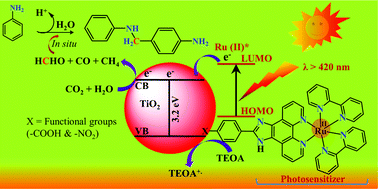Visible light-assisted reduction of CO2 into formaldehyde by heteroleptic ruthenium metal complex–TiO2 hybrids in an aqueous medium†
Abstract
The photocatalytic reduction of CO2 with its simultaneous functionalization is a profound journey to achieve under an ambient condition. In the current research, precedence exists for the formation of HCHO, HCOOH, CO, CH4, and CH3OH after the reduction of CO2 under suitable conditions. In this progression, HCHO is considered to be a reactive molecule, which occurs in the photocatalysis under suitable condition observed in the photocatalytic process. Herein, we report CO2 reduction to formaldehyde via heterogeneous photocatalysis in an aqueous medium at pH 7. The as-synthesized hybrid photocatalyst is capable of being active under visible light (λ > 420 nm) by utilizing the heteroleptic ruthenium metal complex over TiO2 nanoparticles via covalent interactions. The major reaction product was identified as formaldehyde, while trace amounts of CO and CH4 were also detected in the presence of triethanolamine (TEOA) as a sacrificial donor. The maximum turnover number (720) for HCHO was obtained based on the metal complex used over the surface after 5 h visible light irradiation. Furthermore, formaldehyde (in situ) was utilized for the reaction with primary amines (aniline, 4-aminobenzoic acid) to form the corresponding imines under visible light. Directed by mechanistic studies, the results indicate for the first time that the C1 reduced product of CO2 in a heterogeneous medium can be utilized for synthesis of useful products.



 Please wait while we load your content...
Please wait while we load your content...